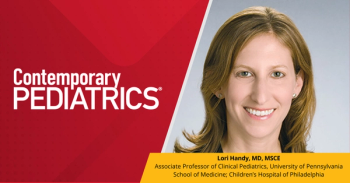
- Consultant for Pediatricians Vol 10 No 4
- Volume 10
- Issue 4
Infant With Persistent Fever and Cough, Worsening Rash
A 14-month-old girl presented with persistent fever, cough, and worsening rash of 5 days’ duration. On the first day of the illness, the infant was brought to an acute care clinic for evaluation.
HISTORY
A 14-month-old girl presented with persistent fever, cough, and worsening rash of 5 days’ duration. On the first day of the illness, the infant was brought to an acute care clinic for evaluation. Upper respiratory tract infection was diagnosed; her parents were instructed to use nasal saline and provide acetaminophen, as needed. Two days before presentation, she was brought to an outpatient clinic, where secondary otitis media on the left side was diagnosed and treatment with amoxicillin, 40 mg/kg/d in 2 doses for 10 days, was prescribed. On the day of presentation, the parents reported that the rash, which began on the cheeks and chest, had spread to other areas and the cough and fever had persisted.
PHYSICAL EXAMINATION
Temperature was 37.6ºC (99.7ºF); respiration rate, 33 breaths per minute, without retractions or signs of distress. Maculopapular rash on the forehead, cheeks, neck, chest, back, and arms, with fewer macules on the upper thighs and sparing of the lower limbs. Gingival mucosa showed some hyperemia of the posterior palate, no enanthem; tonsils red and inflamed, with no white plaques. Infant had been taking solids and liquids without problem. Heart, abdominal, and genital findings normal.
INITIAL LABORATORY RESULTS
White blood cell count of 15,900/µL, with 4% bands, 12% neutrophils, 67% lymphocytes, 9% atypical lymphocytes, and 6% eosinophils; hemoglobin, 11.3 g/dL; and hematocrit 32.4%, with normal red cell indices. Bicarbonate level, 17 mEq/L (normal, 21 to 33 mEq/L), with anion gap of 20 mEq/L; liver enzyme levels normal; and alkaline phosphatase level, 1736 U/L (normal, 108 to 317 U/L).
WHAT'S YOUR DIAGNOSIS?
Results of a heterophile antibody screen were normal. Serological testing revealed an elevated level of IgM antibody to viral capsid antigen (VCA), consistent with a diagnosis of Epstein-Barr virus (EBV) infectious mononucleosis.
INCIDENCE AND ETIOLOGY
Infectious mononucleosis causes viral pharyngitis through proliferation of EBV in the nasopharynx, frequently producing asymptomatic infection in children (50% seroconversion by age 5 years).1,2 Infected college-aged adults usually are symptomatic with fever, sore throat, lymphadenopathy, and fatigue-12% of them seroconvert each year.1-3 EBV proliferates in the nasopharynx, is shed in oropharyngeal and other secretions (including those from the uterine cervix), and is highly contagious. Infected B-cell blasts produce acute heterophile antibodies that are diagnostic in 90% of cases; this IgM response includes antibodies to VCA. The humoral response switches over 3 to 6 weeks to IgG antibodies that target viral proteins or nuclear antigens; these antibodies persist as evidence of past infection and are found in the majority of adults.1-3
Figure – This maculopapular rash on the back of a 14-month-old girl was probably an exacerbation of Epstein-Barr virus infection; her caregivers insisted that the rash was present before amoxicillin administration.
Countering the spread of EBV-infected B cells are the CD8+ cytotoxic T lymphocytes with atypical morphology.2 An efficient T-cell response suppresses the primary EBV infection and enforces transition of B-cell blasts to B memory cells that persist in the oropharyngeal saliva and are detectable in 15% to 25% of healthy adults. Failure of the T-cell response allows uncontrolled B-cell proliferation that can lead to B-cell lymphomas and other EBV-associated conditions (see below).4-8
DIFFERENTIAL DIAGNOSIS
Cytomegalovirus, herpesvirus, adenovirus, HIV, hepatitis B virus, and rubella virus infections can produce fever, pharyngitis, and lymphadenopathy similar to that of infectious mononucleosis; group A streptococcal pharyngitis and even parasitic disease, such as Toxoplasma gondii infection, can also produce these findings.1-8 EBV infection can present with other clinical findings that may include the peripheral rash of Gianotti-Crosti syndrome; the fever, lymphadenopathy, and maculopapular rash of hemophagocytic syndrome; and the fever, cervical lymphadenopathy, and fatigue of Kikuchi necrotizing lymphadenitis.4-8
DIAGNOSIS
Infectious mononucleosis is diagnosed primarily on the basis of the clinical presentation of fever, sore throat, tonsillar enlargement/exudates, generalized lymphadenopathy, erythematous maculopapular rash, and-in teens or adults-a palpable spleen.1,2 Fatigue lasting weeks to months differentiates mononucleosis from streptococcal pharyngitis.2,6
Diagnostic laboratory results may include leukocytosis of 70% or more with lymphocytes of atypical morphology in the peripheral blood smear.3 Elevated liver enzyme levels, mild to moderate thrombocytopenia without purpura, and hemolytic anemia may also be found. Results of the monospot test are unreliable in children younger than 4 years, necessitating a test panel including quantitative heterophile and IgM antibody to VCA, as in this patient.1-3 EBV nuclear antigens appear later and, along with IgG antibodies, may reflect past seroconversion rather than acute infection.2,3
Serological studies help distinguish infectious mononucleosis from other illnesses in the differential diagnosis. However, bone marrow and other studies to rule out leukemia or lymphoma may be considered in the presence of severe thrombocytopenia, hemolytic anemia, persisting unusual lymphocytes, and/or lymphadenopathy.5-8
Newer diagnostic technologies include quantitative measure of EBV viral load in blood or tissues using the polymerase chain reaction assay.2,3 This is helpful in patients with immune suppression, such as those with EBV-associated cancers (eg, Hodgkin disease, nasopharyngeal carcinoma) and AIDS patients with brain lymphomas.7 Detection of EBV-encoded RNA or proteins in tissues by in situ hybridization can complement viral load studies and is particularly useful in patients with posttransplant lymphoproliferative disorder.3
COMPLICATIONS
Airway compromise and breathing difficulties from swollen tonsils and lymphadenopathy may necessitate hospitalization during the acute phase of illness. Administration of a corticosteroid burst (eg, 1 mg/kg of prednisolone every 12 hours for 5 days) may be considered to minimize the hospital stay.9,10
Subcapsular splenic hemorrhage or splenic rupture can occur during the second week of infection. Fortunately, these are rare in children and can be managed conservatively in hemodynamically stable patients using activity limitations, serial CT scans, and monitoring in the pediatric ICU.11
Chronic fatigue syndrome-a complication more common and severe in adolescent girls-may develop within 24 months of EBV infection.6 EBV-related malignancies, including B-cell lymphomas and B-cell lymphoproliferative syndromes (in patients with poor T-cell response), Burkitt lymphoma, nasopharyngeal carcinoma, Hodgkin disease, T-cell lymphomas, and gastric carcinoma, usually occur several years after infection.7 No prophylactic or therapeutic vaccine is yet available for EBV-related malignancies.7
A transient erythematous maculopapular rash located mainly on the torso and upper extremities may occur after amoxicillin administration.12 This rash may unmask the diagnosis, as was the case in this infant (
References:
REFERENCES:
1. Vetsika EK, Callan M. Infectious mononucleosis and Epstein-Barr virus. Expert Rev Mol Med. 2004;6:1-16
2. Cunha BA. Infectious mononucleosis. 2009.
3. Hurt C, Tammaro D. Diagnostic evaluation of mononucleosis-like illnesses. Am J Med. 2007;120:911.e1-8.
4. Ikediobi NI, Tyring SK. Cutaneous manifestations of Epstein-Barr virus infection. Dermatol Clin. 2002;20:283-289.
5. Mendoza N, Diamantis M, Arora A, et al. Mucocutaneous manifestations of Epstein-Barr virus infection. Am J Clin Dermatol. 2008;9:295-305.
6. Katz BZ, Shiraishi Y, Mears CJ, et al. Chronic fatigue syndrome after infectious mononucleosis in adolescents. Pediatrics. 2009;124:189-193.
7. Pagano JS. Epstein-Barr virus: the first human tumor virus and its role in cancer. Proc Assoc Am Physicians. 1999;111:573-580.
8. Stéphan JL, Jeannoël P, Chanoz J, Gentil-Përret A. Epstein-Barr virus-associated Kikuchi disease in two children. J Pediatr Hematol Oncol. 2001;23:240-243.
9. Candy B, Hotopf M. Steroids for symptom control in infectious mononucleosis. Cochrane Database Syst Rev. 2006;3:CD004402.
10. Thompson SK, Doerr TD, Hengerer AS. Infectious mononucleosis and corticosteroids: management practices and outcomes. Arch Otolaryngol Head Neck Surg. 2005;131:900-904.
11. Stephenson JT, DuBois JJ. Nonoperative management of spontaneous splenic rupture in infectious mononucleosis: a case report and review of the literature. Pediatrics. 2007;120:e432-e435.
12. Leung AK, Rafaat M. Eruption associated with amoxicillin in a patient with infectious mononucleosis. Int J Dermatol. 2003;42:553-555.
Articles in this issue
over 14 years ago
Does This Brown Patch on a Boy’s Buttock Signal Underlying Illness?over 14 years ago
The Dx and Tx of Young Children With Disruptive Behavior Problemsover 14 years ago
What Rx Findings Reveal About Teenage Boy’s Elbow Painover 14 years ago
Osteomyelitis Associated With Cat-Scratch Diseaseover 14 years ago
Lymphangioma Circumscriptum With Secondary Cellulitisover 14 years ago
Gastroschisisover 14 years ago
Lodged Spaghetti Strandover 14 years ago
Labial Fusionover 14 years ago
Parameatal Urethral Cystover 14 years ago
Hymenal TagNewsletter
Access practical, evidence-based guidance to support better care for our youngest patients. Join our email list for the latest clinical updates.














